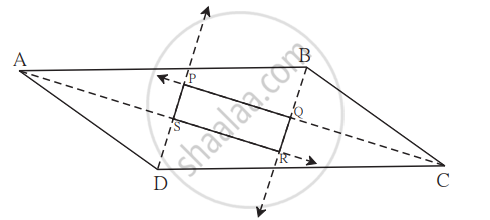Advertisements
Advertisements
Question
The shorter side of a parallelogram is 4.8 cm and the longer side is half as much again as the shorter side. Find the perimeter of the parallelogram.
Solution
\[\text{ Given }: \]
\[\text{ Shorter side } = 4 . 8 cm\]
\[\text{ Longer side } = \frac{4 . 8}{2} + 4 . 8 = 7 . 2 cm\]
\[\text{ Perimeter = Sum of all the sides } \]
\[ = 4 . 8 + 4 . 8 + 7 . 2 + 7 . 2\]
\[ = 24 \text{ cm }\]
APPEARS IN
RELATED QUESTIONS
Diagonals of a parallelogram ABCD intersect at O. AL and CM are drawn perpendiculars to BD such that L and M lie on BD. Is AL = CM? Why or why not?
Which of the following statement is true for a rectangle?
It has two pairs of equal sides.
Which of the following statement is true for a rectangle?
Its diagonals are equal.
Which of the following statement is true for a rectangle?
All rectangles are squares.
Which of the following statement is true for a square?
It is a rectangle.
Using opposite angles test for parallelogram, prove that every rectangle is a parallelogram.
Prove that quadrilateral formed by the intersection of angle bisectors of all angles of a parallelogram is a rectangle.

Diagonals of a rectangle PQRS are intersecting in point M. If ∠QMR = 50° find the measure of ∠MPS.
If the diagonals of a parallelogram are of equal lengths, the parallelogram is a rectangle. Prove it.
If the adjacent angles of a parallelogram are equal, then the parallelogram is a ______.
